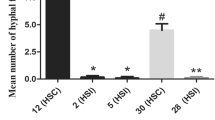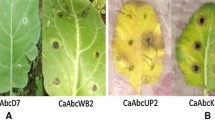Abstract
Colletotrichum lindemuthianum causes bean anthracnose, one of the deadliest diseases that reduces the bean production significantly. Being an ascomycete and ranking among the top important fungi, the specific causes of its significant variation that renders resistant cultivars inefficient warrant further investigation. In India, several studies have been carried out to examine pathogen diversity. However, mechanisms of the genetic variation, on the other hand, remain elusive. To gain insight, a study was conducted, focusing on the role of mitotic recombination in the development of variability. Vegetative compatibility groups (VCGs), which divide the population into groups that can exchange genetic information via heterokaryosis and the parasexual cycle, are of special importance to asexual fungi. One of the strategies utilized in study on vegetative compatibility groups is obtaining nit mutants. The purpose of this study was to collect heterokaryons from diverse C. lindemuthianum races and isolates, group them into VCGs and examine their genetic variability using the nit mutant system. Twenty single spore isolates yielded 120 nit mutants and were assigned to one of six phenotypic classes: nit 1, nit 2, nit 3, nit 5/6, nit M and CRN (chlorate resistant nitrate utilizing). At the same time, 78 mutants were chosen for anastomosis grouping and were divided into 11 VCGs. We obtained nine (HK 1, HK 2, HK 3, HK 4, HK 5, HK 6, HK 7, HK 8 and HK 9) heterokaryons. Seven of the nine heterokaryons were unstable after eight successive subculturing. Prototrophic development is believed to be supported by continuous anastomosis between nearby homokaryotic hyphae, which restores the heterokaryotic condition. As a result, we speculate that the C. lindemuthianum heterokaryons created are more viable than stable. This study identifies the source of bean anthracnose pathogen diversity in northern India, indicating that we must continue to monitor pathogenic variability and focus our breeding efforts on developing anthracnose-resistant bean genotypes.




Similar content being viewed by others
Data availability
All data generated or analysed during this study are included in this published article and its supplementary information files.
References
Banoo A, Nabi A, Rasool RS, Shah MD, Mahiya-Farooq, Ahmad M, Sofi P, Nabi A, Itoo H, Sharma P, Padder BA (2020) North-western Himalayan common beans: population structure and mapping of quantitative anthracnose resistance through genome wide association study. Frontiers in Plant Science 11:571618
Barcelos Q, Souza E, e Silva KJD (2011) Vegetative compatibility and genetic analysis of Colletotrichum lindemuthianum isolates from Brazil. Genetics and Molecular Research 10:230–242
Batista U (1982) Patogenicidad de culturas monoascosporicas de cruzamento entre racas de Colletotrichum lindemuthianum (Sacc. et Magn.) Scrib. Fitopatologia Brasileira 7:285–293
Beynon S, Coddington A, Lewis B, Varzea V (1995) Genetic variation in the coffee berry disease pathogen, Colletotrichum kahawae. Physiological and Molecular Plant Pathologyogy 46:457–470
Bhat NN, Mahiya-Farooq, Padder BA, Shah M, Dar M, Nabi A, Bano A, Rasool RS (2018) Microsatellite mining in the genus Colletotrichum. Gene Reports 13:84–93
Bhunjun CS, Phukhamsakda C, Jayawardena RS, Jeewon R, Promputtha I, Hyde KD (2021) Investigating species boundaries in Colletotrichum. Fungal Diversity 107:107–127
Carvalho CRd, Mendes-Costa MC (2011) Vegetative compatibility and heterokaryon formation between different isolates of Colletotrichum lindemuthianum by using the nit mutant system. Brazilian Journal of Microbiology 42:346–353
Castro-Prado M, Querol C, Sant’Anna J, Miyamoto C, Franco C, Mangolin C, Machado M (2007) Vegetative compatibility and parasexual segregation in Colletotrichum lindemuthianum, a fungal pathogen of the common bean. Genetics and Molecular Research 6:634–642
Clutterbuck AJ (1996) Parasexual recombination in fungi. Journal of Genetics 75:281–286
Correll J, Klittich C, Leslie J (1987) Nitrate nonutilizing mutants of Fusarium oxysporum and their use in vegetative compatibility tests. Phytopathology 77:1640–1646
da Silva Franco CC, de Sant’Anna JR, Rosada LJ, Kaneshima EN, Stangarlin JR, De Castro-Prado MAA (2011) Vegetative compatibility groups and parasexual segregation in Colletotrichum acutatum isolates infecting different hosts. Phytopathology 101:923–928
Edgerton CW (1914) Plus and minus strains in the genus Glomerella. American Journal of Botany 1:244–254
Ferreira JJ, Campa A, Kelly JD (2013) Organization of genes conferring resistance to anthracnose in common bean. In: Translational genomics for crop breeding: biotic stress, vol 1. John Wiley & Sons, Inc, Ames, IA, pp 151–181
Glass NL, Jacobson DJ, Shiu PK (2000) The genetics of hyphal fusion and vegetative incompatibility in filamentous ascomycetes. Annual Review of Genetics 34:165–186
Gordon T, Okamoto D (1992) Population structure and the relationship between pathogenic and nonpathogenic strains of Fusarium oxysporum. Phytopathology 82:73–77
Kimati H, Galli F (1970) Glomerella cingulata (Stonem) Spauld. et V. Shrenk. F. sp. phaseoli n. f., fase ascogena do agente causal de anthracnose do feijoeerio. Anais da escola superior de Agricultura Luiz de Queiroz 27:411–437
Leslie J, Summerell B (2006) Fusarium laboratory workshops–a recent history. Mycotoxin Research 22:73
Liu W, Sundheim L (1996) Nitrate nonutilizing mutants and vegetative compatibility groups in Fusarium poae. Fungal Genetics and Biology 20:12–17
Mahiya-Farooq, Padder BA, Bhat NN, Shah M, Shikari AB, Awale HE, Kelly JD (2019) Temporal expression of candidate genes at the Co-1 locus and their interaction with other defense related genes in common bean. Physiological and Molecular Plant Pathology 108:101424
McGuire IC, Davis JE, Double ML, MacDonald WL, Rauscher JT, McCawley S, Milgroom MG (2005) Heterokaryon formation and parasexual recombination between vegetatively incompatible lineages in a population of the chestnut blight fungus, Cryphonectria parasitica. Molecular Ecology 14:3657–3669
Mehrabi R, Bahkali AH, Abd-Elsalam KA, Moslem M, Ben M’Barek S, Gohari AM, Jashni MK, Stergiopoulos I, Kema GH, de Wit PJ (2011) Horizontal gene and chromosome transfer in plant pathogenic fungi affecting host range. FEMS Microbiology Reviews 35:542–554
Menat J, Cabral AL, Vijayan P, Wei Y, Banniza S (2012) Glomerella truncata: another Glomerella species with an atypical mating system. Mycologia 104:641–649
Milgroom MG, Sotirovski K, Risteski M, Brewer MT (2009) Heterokaryons and parasexual recombinants of Cryphonectria parasitica in two clonal populations in southeastern Europe. Fungal Genetics and Biology 46:849–854
Nabi A, Banoo A, Rasool RS, Dar MS, Mubashir SS, Masoodi KZ, Shah MD, Khan AA, Khan I, Padder BA (2022a) Optimizing the Agrobacterium tumefaciens mediated transformation conditions in Colletotrichum lindemuthianum: A step forward to unravel the functions of pathogenicity arsenals. Letters in Applied Microbiology 75:293–307
Nabi A, Banoo A, Rasool RS, Shah M, Sharma P, Padder BA (2021) Heterothallism among spatiotemporally diverse Colletotrichum lindemuthianum isolates and its implication in common bean anthracnose resistance breeding in the Northwestern Himalayan region. Indian Phytopathology 74:939–947
Nabi A, Lateef I, Nisa Q, Banoo A, Rasool RS, Shah M, Ahmad M, Padder BA (2022b) Phaseolus vulgaris-Colletotrichum lindemuthianum pathosystem in the post-genomic era: an update. Current Microbiology 79:1–13
Oliveira VCd, da Costa JL (2003) Compatibilidade vegetativa de nit-mutantes de Fusarium solani patogênicos e não-patogênicos ao feijoeiro e à soja. Fitopatologia Brasileira 28:89–92
Özer G, Bayraktar H, Tsror L, Yaman T, Kabakcı H, Göre M (2018) Vegetative compatibility groups in Colletotrichum coccodes from Turkey and their aggressiveness to potato. Plant Pathology 67:1735–1739
Padder BA, Sharma PN, Awale H, Kelly JD (2017) Colletotrichum lindemuthiam the casual agent of bean anthracnose. Journal of Plant Pathology 99:317–330
Padder BA, Sharma PN, Sharma OP (2009) Virulence and RAPD data - a tool to study the evolutionary trends of Colletotrichum lindemuthianum virulences in the North Western Himalayan region of India. Archives of Phytopathology and Plant Protection 42:610–617
Padder BA, Sharma PN, Sharma OP, Kapoor V (2007) Genetic diversity and gene flow estimates among five populations of Colletotrichum lindemuthianum across Himachal Pradesh. Physiological and Molecular Plant Pathology 70:8–12
Pastor-Corrales M, Otoya M, Maya M (1993) Diversity in virulence of Colletotrichum lindemuthianum in Mesoamerica and Andean region. Fitopatologia 17:31–38
Pastor Corrales M (1996) Traditional and molecular confirmation of the coevolution of beans and pathogens in Latin America. Bean Improvement Cooperative. Annual Report (USA) 39:46–47. https://handle.nal.usda.gov/10113/IND20562614
Pathania A, Sharma PN, Sharma OP, Chahota RK, Bilal A, Sharma P (2006) Evaluation of resistance sources and inheritance of resistance in kidney bean to Indian virulences of Colletotrichum lindemuthianum. Euphytica 149:97–103
Paugh KR, Gordon TR (2020) The population of Fusarium oxysporum f. sp. lactucae in California and Arizona. Plant Disease 104:1811–1816
Primo Pd, Cartia G, Katan T, di Primo P (2001) Vegetative compatibility and heterokaryon stability in Fusarium oxysporum f.sp. radicis-lycopersici from Italy. Plant Pathologyogy 50:371–382
Puhalla JE (1985) Classification of strains of Fusarium oxysporum on the basis of vegetative compatibility. Canadian Journal of Botany 63:179–183
Puhalla JE, Spieth PT (1983) Heterokaryosis in Fusarium moniliforme. Experimental Mycology 7:328–335
Rodriguez-Guerra R, Ramirez-Rueda MT, Cabral-Enciso M, Garcia-Serrano M, Lira-Maldonado Z, Guevara-Gonzalez RG, Gonzalez-Chavira M, Simpson J (2005) Heterothallic mating observed between Mexican isolates of Glomerella lindemuthiana. Mycologia 97:793–803
Rohlf FJ (1993) NTSYS-pc version 1.80. Distribution by Exeter Software, Setauket, New York
Rosada LJ, Franco CC, Sant’Anna JR, Kaneshima EN, Gonçalves-Vidigal MC, Castro-Prado MA (2010) Parasexuality in race 65 Colletotrichum lindemuthianum isolates. Journal of Eukaryotic Microbiology 57:383–384
Sharma N, Kumari N, Sharma SK, Padder BA, Sharma PN (2019) Investigating the virulence and genetic diversity of Colletotrichum lindemuthianum populations distributed in the North Western Himalayan hill states. Journal of Plant Pathology 101:677–688
Sharma PN, Kumar A, Sharma OP, Sud D, Tyagi PD (1999) Pathogenic variability in Colletotrichum lindemuthianum and evaluation of resistance in Phaseolus vulgaris in the North-Western Himalayan region of India. Journal of Phytopathology 147:41–45
Sharma PN, Padder BA, Sharma OP, Pathania A, Sharma P (2007) Pathological and molecular diversity in Colletotrichum lindemuthianum (bean anthracnose) across Himachal Pradesh, a north-western Himalayan state of India. Australasian Plant Pathology 36:191–197
Vaillancourt LJ, Hanau RM (1994) Nitrate-nonutilizing mutants used to study heterokaryosis and vegetative compatibility in Glomerella graminicola (Colletotrichum graminicola). Experimental Mycology 18:311–319
Wilson AM, Lelwala R, Taylor P, Wingfield M, Wingfield B (2021) Unique patterns of mating pheromone presence and absence could result in the ambiguous sexual behaviours of Colletotrichum species. G3 Genes Genomics Genetics 11:jkab187
Zamani M, Motallebi M, Rostamian A (2004) Characterization of Iranian isolates of Fusarium oxysporum on the basis of RAPD analysis, virulence and vegetative compatibility. Journal of Phytopathology 152:449–453
Acknowledgements
The corresponding author thanks SERB New Delhi (grant no. CRG/2018/000626) and DBT, New Delhi (grant no: BT/PR38582/103/1245/2020), for financial assistance.
Author information
Authors and Affiliations
Contributions
BAP conceived the idea, wrote and edited the manuscript. This manuscript is a part of master’s dissertation of RJ who performed the experiments. Isolates were collected by MDS, AN, T, AB, IL, RAS and HI. QN, T and NN maintained the monoconidial isolates. Data was analysed by RJ, BAP and IK. TAS, RR and FAL were the advisory committee members for RJ.
Corresponding author
Ethics declarations
Conflict of interest
The authors declare no competing interests.
Additional information
Publisher's note
Springer Nature remains neutral with regard to jurisdictional claims in published maps and institutional affiliations.
Supplementary Information
Below is the link to the electronic supplementary material.
Rights and permissions
Springer Nature or its licensor (e.g. a society or other partner) holds exclusive rights to this article under a publishing agreement with the author(s) or other rightsholder(s); author self-archiving of the accepted manuscript version of this article is solely governed by the terms of such publishing agreement and applicable law.
About this article
Cite this article
Junaid, R., Shah, T.A., Nabi, A. et al. Vegetative compatibility and heterokaryon stability among diverse Colletotrichum lindemuthianum isolates of Northwestern Himalayan region. Trop. plant pathol. 48, 293–302 (2023). https://doi.org/10.1007/s40858-023-00564-x
Received:
Accepted:
Published:
Issue Date:
DOI: https://doi.org/10.1007/s40858-023-00564-x




